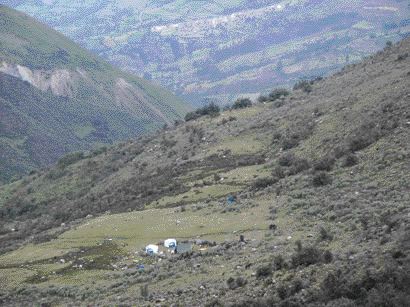If location is everything in exploration as it is in real estate, Strait Gold’s (SRD-V) Culebrilla property in the Andes Mountains, near Ancash, Peru, has the company in good shape.
Culebrilla is wedged between two of Barrick Gold’s (ABX-T, ABX-N) best mines — Pierina, which produced 628,000 oz. gold in 2005, and Lagunas Norte, which poured a record-setting 1 million oz. in 2006. One of the world’s largest gold mines, Newmont Mining’s (NMC-T, NEM-N) Yanacocha mine, is also along the same trend as Culebrilla.
Geography aside, the 68-sq.-km gold-silver-copper property hosts widespread mineralization.
Recent surface sampling uncovered grades up to 14.4 grams gold per tonne, 1,365 grams silver and 2.04% copper.
“They are by no means isolated,” says Strait Gold president Jim Borland. “We do have consistent values of well over one to two grams gold, and silver over one hundred grams throughout the property.”
The focus for now is on the former artisanal mining areas, Alalaj and nearby Culebrilla. Both had extensive surface rock showings: grab samples at Alalaj returned grades of up to 14.4 grams gold per tonne, 1,220 grams silver, 2.01% copper and 0.19% zinc; and Culebrilla yielded grades of 9.98 grams gold and 200 grams silver.
The company is currently identifying targets for an 8- to 10-hole diamond-drill program, regional reconnaissance mapping and stream- sediment sampling to identify areas of unknown mineralization.
It’s also planning to do detailed bedrock mapping and a ground magnetic geophysical survey over a 2.5 by 1.5-km grid.
Much of the sampling is being done at high altitudes; Alalaj is 4,500 metres above sea level.
“At this point, there is simply a trail up — horses can make it up easier than men and women can walking,” Borland says. “It’s an adventure going up there, I’ll tell you.”
But Borland says the trek won’t stop Strait Gold from taking a portable rig to the site.
“A road obviously is an expensive proposition, but it does add a lot of other value to the property,” Borland says.
A gravel highway crosses the eastern part of the property, but that road is far from Strait Gold’s focus area.
There’s also a paved airstrip used by the nearby Antamina mine, which has been used by other companies, and there are power lines within 1 km of the property.
The family that sold the property to Strait Gold has being going up to Culebrilla since the mid-1990s. The property has never been drilled, though several small-scale producers have operated there in the past.
Strait Gold became a private company in 2003, around the time when geologist and director Roger Moss discovered Culebrilla. Moss also helped discover AngloGold Ashanti’s (au-n, agd-l, anano-j) Navichab mine in Namibia.
The company, based in Toronto, went public in late October and currently has a market capital of $6 million with 15 million shares outstanding and 21 million fully diluted.


Be the first to comment on "Strait Gold nestles into Peru’s golden area (December 25, 2006)"